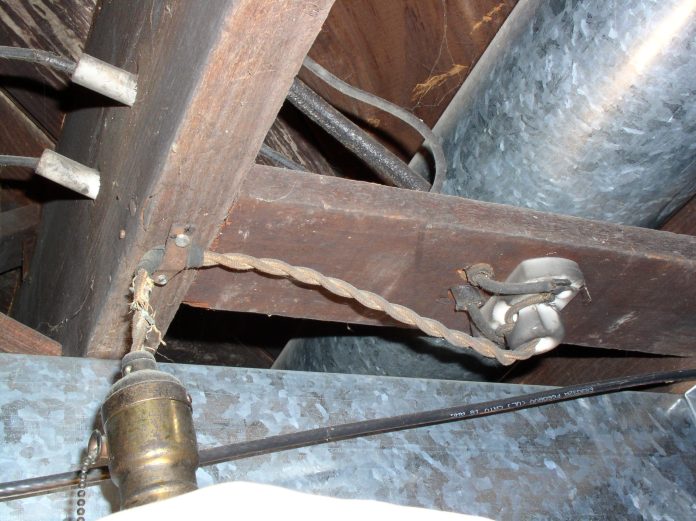Last Updated on April 1, 2023 by admin
Knob and tube wiring
Copper wire is insulated and passed through ceramic tubes or knobs in the knob and tube wiring method. The wire passes through ceramic pipes through walls, studs, or beams. Wires are suspended away from walls and supported by porcelain knobs. In the same way, the glass insulators between the wire and the pole work at the top of a telephone pole.
In the days before World War II, knob and tube wiring was an excellent option. It was three times more expensive to install conduit or armored cable wiring than other methods available at the time.
The knob and tube were more than adequate for powering period appliances, and if it was installed correctly, it was pretty safe. In addition, ceramic knobs and tubes had a virtually indefinite lifespan if they were not damaged. Throughout North America, knob and tube wiring have been popular for more than forty years because of their benefits!
Since knob and tube wiring was not regulated like modern wiring systems, its popularity declined after World War II. As a result, each wiring scheme was unique, and installation required more time. Because of the chaotic nature of the building, repairs took a long time and were dangerous. The cost of installing standardized wiring decreased as labor costs increased.
The purpose of partially replacing knob and tube wiring
Rewiring a house will inevitably prove to be an expensive proposition since it will usually require the removal of some wall coverings so that old wires can be removed and new cables can be installed.
Most homeowners opt for partial rewiring to save money, but incorrectly tying new wires to an existing knob and tube wiring adds one more hazard. Even if you do nothing but replace old wires with frayed basement insulation, it’s better than nothing.
It is mandatory to use code-approved junction boxes for all wire connections. If you find a knob and tube junction box in your house, you should replace it immediately because it does not comply with the code. Be aware that the circuit may overheat when you use knob and tube wiring to power large appliances or multiple devices simultaneously.
Read more: Each And Everything You Should Need To Know About Shunt Trip Breaker
Replacing knob and tube wiring: Step-by-step instructions
In the event that your knob and tube wiring system is aging, it may need to be removed and replaced. Modern electricians use modern designs, making it difficult to continue using an outdated application like K&T. The only thing you’ll gain by tampering with it is time. The only way to update an existing knob and tube system is to replace it completely, as ground wire cannot be added.
Furthermore, exposed wires should be replaced immediately when they appear. Copper wiring revealed elsewhere is likely also exposed elsewhere, which means your home is prone to fires or other electrical problems.
Here are the steps you can follow as a homeowner to replace knob and tube wiring.
- Do not attempt this on your own. Doing electrical work on an old system alone is never recommended, especially in this case. It can be challenging to navigate, and finding replacement parts can be challenging.
- Ensure your home’s electrical system is properly inspected by your local electrician, such as Electric City.
- Make sure you get an estimate! Your rewiring budget is more likely to be accurate the sooner you receive an estimate. For a complete home rewire, you should expect to spend between $5,000 and $15,000. Depending on the size and number of stories of your house, you can expect a wide range of costs.
- Set up a time for it to be done. You will probably be without power for a few days during the work, so keep your fridge and freezer empty and prepare to stay elsewhere overnight while the work is being done.
- Enjoy your new wiring! The installation of new wiring allows you to run as many appliances as you like without worrying about blown fuses or power outages.
Knob and tube wiring’s lifespan
The lifespan of copper wiring can reach 100 years. Unlike knob and tube wiring, knob and tube wiring can last a long time, but one of the significant problems with knob and tube wiring is worn old insulation. Therefore, it tends to become brittle and can break off easily, leaving exposed bare wires. According to experts, the insulation should be replaced as soon as it becomes crispy.
The cost of replacing an entire system with copper wiring will vary dramatically depending on the size of the home and the amount of k&t wiring installed. In addition to not costing much, it can be done relatively quickly and with little damage. By improving energy efficiency and safety, you’ll increase the resale value of your home.
Cost of replacing knob and Tube wiring
Removing and rewiring knob and tube wiring costs an average of $3,500 to $8,000. Due to the fact that this is not new wiring, your contractor will have to estimate the cost of rewiring and repairing walls and ceilings, which could easily add up to $15,000.
A building’s rewiring will require many access holes, which must be covered with sheetrock or another wall covering, significantly increasing the cost.
Upgrades from knob and tube to modern wiring are challenging to estimate since the cost will vary so much with the size and complexity of the home, the amount of wiring that needs to be replaced, the labor cost in your area, and the electrician’s skill.
Considerations for replacing knob and tube wiring
It may be necessary to tear down walls and ceilings to access the higher floors of the house to install a new electrical system depending on how complex the replacement will be.
If the distribution panel was never upgraded at a house with a knob and wiring, the house might also have other problems, such as burst or frozen pipes and asbestos insulation that has not been treated. It is therefore essential to consider the cost of fixing these problems.
You may encounter knob and tube wiring problems if you install the wrong outlets or switches when replacing them with aluminum wiring.
Despite the possibility that the first type of replacement may cost you less, repairing damaged walls may be more expensive. After discussing the damage with the electrician, please choose the best option based on its complexity.
Apart from this, if you are interested to know more about Plan Your Home Interior Design in Dubai then visit our Home improvement category.
FAQs (Frequently Asked Questions)
Does the knob and tube wiring need to be removed?
It is necessary to remove all visible knob and tube wiring from unfinished basements and attics. A general rule is that knob, and tube wiring must be removed entirely everywhere visible. In concealment areas such as walls and ceilings, the KT wire must be deactivated.
Does the knob and tube wiring need to be replaced?
New homes cannot use knob and tube wiring because it is obsolete, but older homes are not 100% required to remove it. Despite this, it’s highly recommended that you replace these old systems. During the course of time, the material can become very brittle.
























